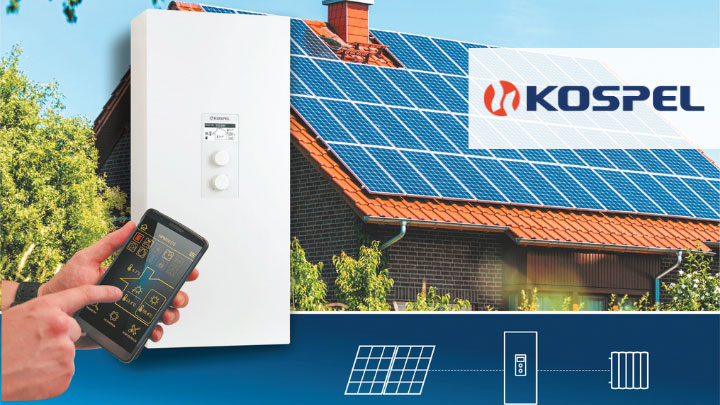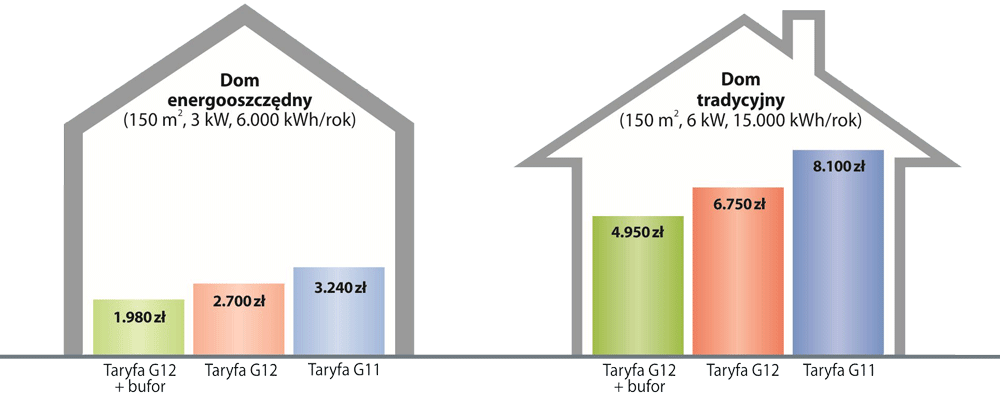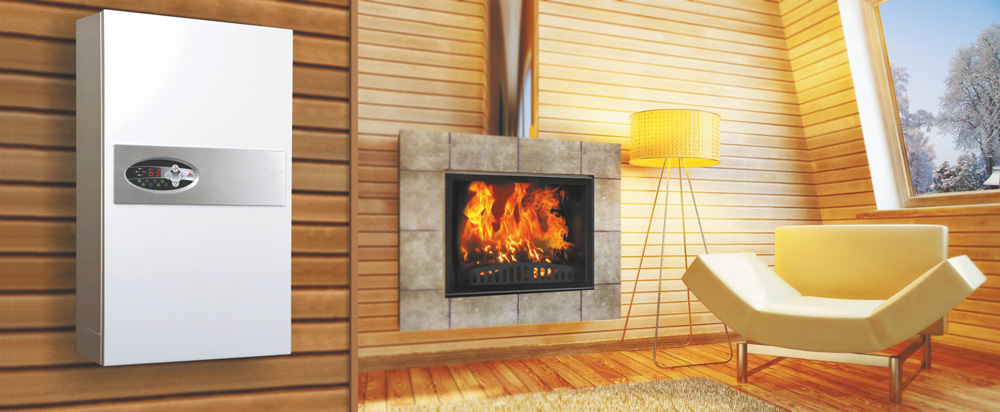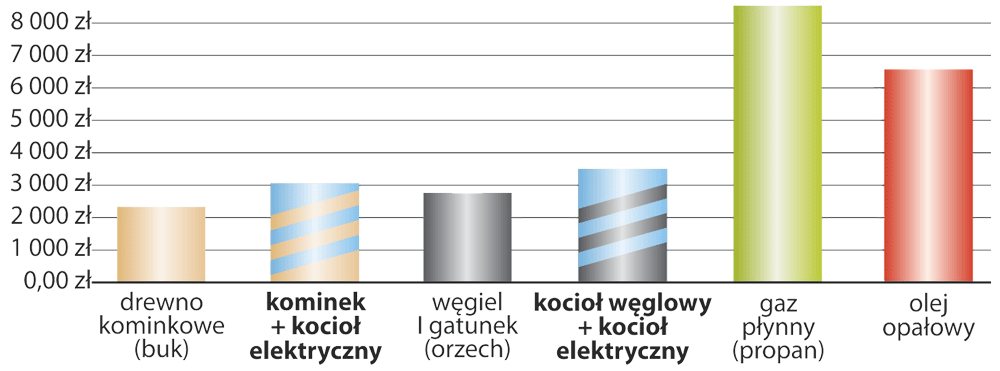Heating with an electric boiler is an ideal solution in energy-saving construction, low investment costs, easy installation, comfortable operation and safety.

Electric heating still seems relatively expensive in the minds of many investors. However, it should be taken into account that modern technologies used in construction have resulted in a significant decrease in energy consumption for heating purposes. At the same time, electricity is and will always be the most widely available, comfortable and safe medium to use.
See electric boilers at the Onninen wholesaler
It is worth analyzing the arguments for using an electric boiler:
- Perfect in energy-saving construction. Annual costs of heating with an electric boiler in a house with an area of 150 m² and heat demand of 6,000 kWh/year using a cheaper tariff and heat accumulation buffer amount to PLN 2,000.
- Cooperation with a solid fuel boiler or a fireplace. Using a solid fuel boiler or a fireplace with a water jacket is the cheapest in terms of operating costs. However, it is the least comfortable. Connecting an electric boiler to the installation ensures maintenance-free operation and improves comfort while maintaining low operating costs.
- Low investment costs. Building a heating system based on an electric boiler is cheaper than a gas, oil or solid fuel boiler. The price of the electric boiler itself is competitive. The costs of gas connection, chimney construction and chimney liner are eliminated. There is an electrical connection in every building and the boiler installation is easy and does not require special rooms.
- No gas. If access to the gas network is difficult, an electric boiler is the best solution. Solid fuel is not very comfortable, and liquefied gas or heating oil are expensive to invest and operate. Electrical installation is available in every home and the cost of installing an electric boiler is low. If the building is well insulated and heat is accumulated in a cheap energy tariff, the cost of heating with an electric boiler is low.
- Comfortable operation. Electric boilers are comfortable to use. Equipped with appropriate control, they operate fully automatically and their operation basically comes down to switching to summer or winter mode.
- Low service costs. Electric boilers practically do not require periodic inspections. Therefore, the costs of inspection of the gas, chimney and ventilation installations are eliminated.
- Operational safety. According to the fire brigade, during the heating season there are even several thousand incidents related to carbon monoxide, including over 100 fatalities! Concentrated carbon monoxide (carbon monoxide), which can escape from faulty gas, oil or solid fuel boilers, can kill in as little as 60 seconds. The use of an electric boiler does not pose a risk of carbon monoxide poisoning or explosion.
- Aesthetics and ease of installation. Electric boilers are small devices with an aesthetic appearance that can be easily hung on the wall in virtually any room.
- Ecology. Electricity does not increase environmental pollution. Harmful substances are not produced in homes, but where energy is produced - in power plants where exhaust gases are effectively purified.
How much does heating with an electric boiler cost?
Heating costs depend on a number of factors. The price of energy itself is only one of them, and not the most important one. It is worth knowing what to take care of and what to do to reduce heating costs even several times.
1. Technology and standard of building insulation
The greatest impact on heating costs has the building's heat demand, i.e. the technology in which the building is constructed and the heat losses that occur in it. A well-thought-out design of the building (its shape) and a location that takes advantage of natural conditions (e.g. appropriate glazing on the south side to "catch" as much solar energy as possible) are very important. The table presents the calculated demand for thermal power and energy demand for heating depending on the building standard (these are approximate values, the real demand of the building should be determined on the basis of the energy characteristics prepared by an authorized person). It is clear that heating costs in an old building can be many times higher than in a new, energy-efficient house!
| Calculated demand for thermal power | Heat demand | |
|---|---|---|
| Old building - poor thermal insulation | approx. 100 W/m 2 | approx. 200 kWh/m 2 /year |
| New building - good thermal insulation | approx. 40 W/m 2 | approx. 100 kWh/m 2 /year |
| Energy-saving building | approx. 20 W/m 2 | approx. 40 kWh/m 2 /year |
2. Basic principles of energy-saving heating
- Appropriate control of the installation operation - limiting the temperature in rooms when residents are not at home and using weather control can result in energy savings of up to over 30%.
- Do not overheat rooms - every 1°C more means 6% higher heating costs.
- Radiators should not be covered.
- Temperature sensors and thermostats should be placed in places where they are not exposed to accidental cooling (drafts) or heating (e.g. by sunlight).
- Proper airing of rooms involves briefly opening full-width windows while closing thermostatic valves, which allows for the exchange of fresh air without excessive cooling of the rooms.
3. Energy tariff
Heating costs also depend on the appropriate selection of the electricity tariff. Fees vary depending on the energy seller. On average in Poland, according to prices from 2015, in the 24-hour G11 tariff, the cost of 1 kWh is PLN 0.54. For heating purposes, it is generally best to choose the G12 or G12w (weekend) tariff. In the case of the G12 tariff, cheaper energy can be used between: 22:00 - 6:00 and 13:00 - 15:00, i.e. 42% of the time, which gives an average price for 1 kWh of PLN 0.49.
See electric boilers at the Onninen wholesaler
4. Buffer for heat accumulation
Using the cheaper G12 energy tariff, it is worth additionally accumulating heat. A buffer tank is used for this purpose. In a building with an area of 150 m2, in which the demand for thermal power is 6 kW (40 W/m2), using underfloor heating - a buffer with a capacity of 600 - 800 l should ensure the operation of the boiler at a cheap tariff for 80 - 100% of the time during the heating season. In this case, the average cost of 1 kWh drops to as much as PLN 0.33.

Comparison of annual heating costs in an energy-efficient and traditional house with an area of 150m 2 , using different electricity tariffs and using a buffer for heat accumulation in a cheaper tariff, (prepared by Kospel, average prices 09/2015).
Cooperation of an electric boiler with a fireplace or solid fuel boiler
 The use of solid fuel is currently the cheapest to operate, but it is not very comfortable. In the case of a fireplace and a solid-fuel boiler, remember to regularly replenish fuel and clean the devices. Another inconvenience is the inability to leave the boiler room unattended, and a longer trip, e.g. on holiday, involves the risk of the installation freezing.
The use of solid fuel is currently the cheapest to operate, but it is not very comfortable. In the case of a fireplace and a solid-fuel boiler, remember to regularly replenish fuel and clean the devices. Another inconvenience is the inability to leave the boiler room unattended, and a longer trip, e.g. on holiday, involves the risk of the installation freezing.
These problems are eliminated by an electric boiler, which will support heating when, for various reasons, it is not possible to replenish fuel. It will turn on fully automatically only when, for example, the fire in the fireplace goes out in the morning. When all household members go on holiday, it will maintain the anti-freeze temperature.
Installing an electric boiler involves small investment outlays, much lower than in the case of gas or oil boilers. At the same time, electricity consumption will be low. The graph presents a comparison of heating costs for a detached building with an area of 150 m2, in which the annual energy demand for heating is 15,000 kWh. The calculations assumed that the electric boiler would operate as a support for an average of 20% of the time during the heating season.
It is clearly visible that the use of an electric boiler in combination with a fireplace or a coal boiler only slightly increases the operating costs. However, the benefits resulting from the much greater comfort of use of the entire system are enormous.

Comparison of heating costs with different energy sources (prepared by Kospel, average prices in Poland, March 2015).
Heating in an energy-efficient house – electric boiler or heat pump?
Energy-efficient construction is characterized by low energy demand for heating purposes. The question arises whether it is worth incurring the huge investment costs associated with installing a heat pump? Is it worth building a gas connection, a special chimney liner and a gas boiler room?
Can you install a modern, comfortable and safe electric boiler without incurring unnecessary financial outlays?
So what does the investment and operating costs of an electric boiler compare to a heat pump for an example house with an area of 150 m² and a heat demand of 6,000 kWh/year?
A ground heat pump costs approximately PLN 40,000 (price of the pump and construction of the ground collector). Assuming an average annual COP of 4.0, the pump will consume 1,500 kWh of energy. Using the G12 tariff, the average cost of 1 kWh is PLN 0.45 (ENEA price list 2015). Therefore, the annual cost of heating with a heat pump will be PLN 675.
An electric boiler with a 400 l buffer costs PLN 6,000. The boiler will consume 6,000 kWh of energy. Using the G12 tariff and heat accumulation, the average cost of 1 kWh will be PLN 0.33 (ENEA price list 2015). Therefore, the annual cost of heating with an electric boiler will be PLN 1,980.
A simple calculation shows that installing a heat pump is PLN 34,000 more expensive, the difference in annual operating costs is PLN 1,305. This means that the investment in a heat pump will pay off only after over 26 years!
It can be assumed that after such a period of time, new technological solutions will be available and the heating system will require modernization. It should also be remembered that for such a long time there will be service and post-warranty costs, which will most likely be much higher in the case of a heat pump.

In the case of a house built using traditional technology (area 150 m², annual heat demand approx. 15,000 kWh), the difference in annual operating costs will increase to PLN 3,260. In this case, the return on investment in a heat pump is faster, but it is still over 10 years!